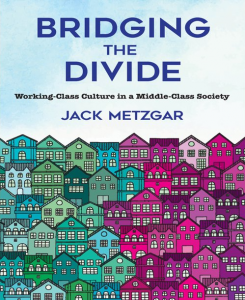Bridging the Divide
 Bridging the Divide: Working-Class Culture in a Middle-Class Society, by Jack Metzgar (Ithaca: Cornell University Press, 2021)
Bridging the Divide: Working-Class Culture in a Middle-Class Society, by Jack Metzgar (Ithaca: Cornell University Press, 2021)
Professionals who have crossed the divide from working class to middle class in their careers are often uneasy for having left their former perspectives and values. Jack Metzgar offers reassurance that such a passage is both common and beneficial. He made it himself and is writing about it. A son of a Pennsylvania steelworker, author of Striking Steel (2000), and Professor Emeritus at Roosevelt University in Chicago, he contends that his past has always remained with him. In clinging to it, he retained much cultural baggage, and discovered the advantages of having done so.
Born in 1943, Metzgar “grew up during a thirty- or forty-year period [1945-1975] when mediocrity was more greatly valued and also easier to achieve than at any time in human history.” Translating the 1979 French phrase, Les Trentes Glorieuses, into “The Thirty Glorious,” Metzgar dissects this era and his relation to it. He is not nostalgic for his advantages during the 1950s, when as a “straight white guy” he was one of the “uncontested kings, even among the poor and working class.” Nevertheless, thinking positively, he concedes that he benefited “in a variety of ways,” from such developments as women’s liberation and the civil rights revolution. Most significantly, “these were years of superior economic growth,” and despite its consumerism, religious fundamentalism, and emergence of “couch potatoes,” there was also “newfound freedom of time and money … for people to use, misuse, or both.”
As Metzgar explains at length, there was profound union power and Black advancement. The “Glorious Thirty” featured “two of the greatest strike waves in our history, 1945-1946 and 1967-1971,” and collective union action yielded huge gains from the some of the world’s leading business organizations, which resulted in strong prosperity. For Black America there was a sharp increase in family income and an assault on racial segregation via the Civil Rights Acts of 1964, 1965 and 1968. Amazingly, the prosperity also sparked “liberatory movements” among several additional groups, such as gays, women and Latins. For the moment, both “middle-class professionalism” and “working-class culture” gave credence to the American Dream.
When the bubble burst, as perhaps best symbolized by the American withdrawal from Vietnam, Metzgar gained additional insight into that vision. The new national landscape featured “Rust Belt” cities and widespread hardship, which necessitated a national reexamination of cultural values, including the idea of upward mobility. Significant victims of the downturn, working-class workers demanded recognition of their value to society. Workers as well as professionals sought respect, but in different, but equally valid ways. The former sought to “be perceived as good workers,” while the latter wanted “to be perceived as doing excellent or outstanding work.”
Metzgar contends that differences between working-class and middle-class culture deserve to be understood rather than produce condescension. For example, in raising children the upper middle class exerts “unrelenting pressure . . . to excel.” On the other hand, working-class parents are deferential. They “counsel their children to be obedient, particularly in school but also to all adults.” Success arises from “simple obedience” as well as a “strategy” of recognizing and overcoming adversity. “Parents want their kids to stay out of trouble and have the strength of character to steadily endure hard work for almost all of their lives.” Another difference is evident in measuring achievement. Whereas working-class aspirations often tend to be “solidaristic,” with community uplift a serious goal, middle-class folk are more “individualistic,” stressing a limited beneficiary. Metzgar’s message is clear: these values merit mutual respect.
Adhering to his autobiographical path, he identifies himself as “cross-cultural,” with his working-class roots permanently imbedded. The values remain, and a commitment to belonging remains even as people continue to “belong” even as they “become” members of different professions. There is no abandoning of the past. Metzgar’s “problem,” as he describes it, is the “parochial self-assurance that that there is only one right way, and that we’re it.” His aim is to persuade middle-class professionals that they and the nation have much to gain from exposure to the working class. That he states his case in politically-polarized times without engaging in conventional, divisive rhetoric is a major achievement.
Reviewed by Robert D. Parmet, Professor of History, York College of the City University of New York
